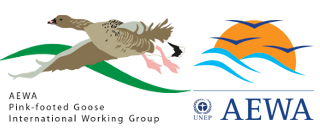Current Size: 76%
Norwegian ‘MIGRAPOP’ Project
Summary
Foraging on crops by migratory geese has increasingly been the cause of conflict with agricultural interests in Norway. This project sets out to provide a framework for a more all-inclusive and adaptive approach for managing goose related agricultural conflicts. Its focus is at the regional management level in Central & North Norway, with scientists, managers and users collaborating in the process of decision making.
Description
The project consists of several work packages intended to firstly: develop and test a series of experimental and modelling tools including, species distribution and resource depletion models, as well as population models. These will enable and help managers to choose the best and most suitable management initiatives to balance ecological, economic, agricultural and social interests. Secondly, the feasibility of setting up appropriate political-administrative capacity will be evaluated, assessing the decision making processes as well as stakeholder interests and commitment. The main spring staging sites for the pink-footed goose in Norway, Nord-Trøndelag and Vesterålen, will be the study sites.
The results will further scientific knowledge of ecological processes and potential management interventions and administrative structures at a regional level. In turn, this learning has implications for the management of the entire Svalbard population of the pink-footed goose internationally. Hence, it is a test case and will provide relevant input for the International Species Management Plan.
Collaborations and funding
This Norwegian led project is carried out in collaboration with researchers from a number of national and international institutions including: Norwegian Institute for Nature Research (NINA), The Norwegian Institute for Cultural Heritage Research (NIKU), Bioforsk, Aarhus University, Netherlands Institute of Ecology and Alterra-Wageningen University and Research Centre.
The project receives funding from: the Research Council of Norway, the Norwegian Ministry of Environment, the County Governor of Nordland, the County Governor of Nord-Trøndelag, Sortland Municipality, the Fram Centre, Aarhus University and Netherlands Institute of Ecology.
Timeframe
The project was started in 2011 and finishes in 2013.
Recent work and publications
An assessment of the historical background and impact of a regional subsidy scheme established in 2006, covering important stopover sites for geese in Central & North Norway, was recently concluded and its findings published. The article assesses the efficiency of the subsidy scheme in one particular region, Vesterålen, in terms of its conflict mitigation which is reflected in a near discontinuation of scaring activities in the region. The article is published on PLOSone and a PDF copy is available below.
(Reference: Tombre IM, Eythorsson E, Madsen J (2013) Towards a Solution to the Goose-Agriculture Conflict in North Norway, 1988–2012: The Interplay between Policy, Stakeholder Influence and Goose Population Dynamics. PLoS ONE 8(8): e71912, doi:10.1371/journal.pone.0071912)
In spring 2012, goose grazing experiments were established at four farms in Vesterålen, North Norway. The experiment used exclosures to prevent goose grazing and plots that were open for grazing, to test the effects of variable grazing intensity on dairy grassland yields. This field study indicates that grazing on grasslands by pink-footed geese can reduce yields by about a quarter. The full results and findings have been published and abstract of the article is available on the Wiley On-line Library.
(Reference: Bjerke et al (2013) Reduced dairy grassland yields in Central Norway after a single springtime grazing event by pink-footed geese , Grass and Forage Science, doi: 10.1111/gfs.12045.)
















